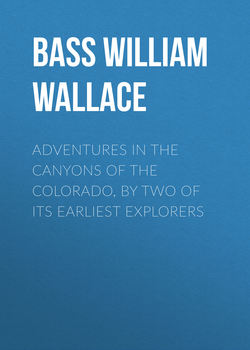Adventures in the Canyons of the Colorado, by Two of Its Earliest Explorers

Реклама. ООО «ЛитРес», ИНН: 7719571260.
Оглавление
Bass William Wallace. Adventures in the Canyons of the Colorado, by Two of Its Earliest Explorers
FOREWORD. BY GEORGE WHARTON JAMES
INTRODUCTION. BY W. W. BASS
PART II. THE STORY OF JAMES WHITE, THE FIRST MAN TO PASS THROUGH THE CANYONS OF THE COLORADO RIVER
Отрывок из книги
My interest in the Grand Canyon dates from soon after my arrival, in July, 1883, at Williams, Arizona. I had come West for my health on the still uncompleted line of the Santa Fe route, then known as the "Atlantic & Pacific." Williams was a railroad construction town and vied with Kingman in its "wild and woolly" reputation, but I located there and soon began to improve in health. In one of my exploring trips (the story of which is fully told in my life history, soon to be published), I found it necessary to refer to the available maps in order to secure what information was possible as to water locations and the general contour of the country I desired to explore. I succeeded in securing a Government map, and, as it was one with the name of J. W. Powell as Director of the Geological Survey, I supposed it was correct and reliable. But, to my dismay, after four days' journey following the dry washes and valleys I found myself farther away from the walls of the Grand Canyon than when I started. The water-holes and tanks were a myth and my animals nearly famished before I could retrace my steps to where I knew I could save them. In a word, the drainage system as shown on his map was a delusion and a snare and nearly resulted in my disaster.
Naturally, this incident made me suspicious ever after of anything Powell claimed to have done in this particular region, but it remained for me to have some very positive evidence as to the reliability of his claims in another direction. Up to this time I had never met him and when in 1887 he employed me as guide in some triangulation work on the Bill Williams Mountain I was thoroughly convinced as to the doubtful character of certain statements he made to me regarding other work of the same nature he claimed to have done some years previous. One in particular was as to a station he said I would find on "Red Butte," which lies about forty-five miles northeast of Williams and is a prominent feature on the landscape, as it is the only one to be seen anywhere along the south wall of the Grand Canyon for a distance of over fifty miles. It lies in the plain about twelve miles from the Canyon wall. As I had spent considerable time there only a few days previous in looking for a silver prospect reported to be there, I knew there was no such pile of rocks as he described and never had been within the knowledge of the oldest inhabitant in this region. I could not find enough rocks on the top of that mountain to build a respectable mining location. I also knew of others who had been there on the same mission and they can verify this statement. In addition to this the later geological work in this section failed to locate any such station as was claimed by him to me.
.....
When, therefore, a monument was erected to Powell on the south rim of the Grand Canyon, with money appropriated by the Congress of the United States, and a full list of the men who accompanied him on both expeditions was presumably given on the bronze tablet placed on that monument, it was with considerable astonishment that I noted that the names of three men who accompanied the first expedition were omitted.
These men were O. G. Rowland, Seneca Rowland and William Dunn.
.....